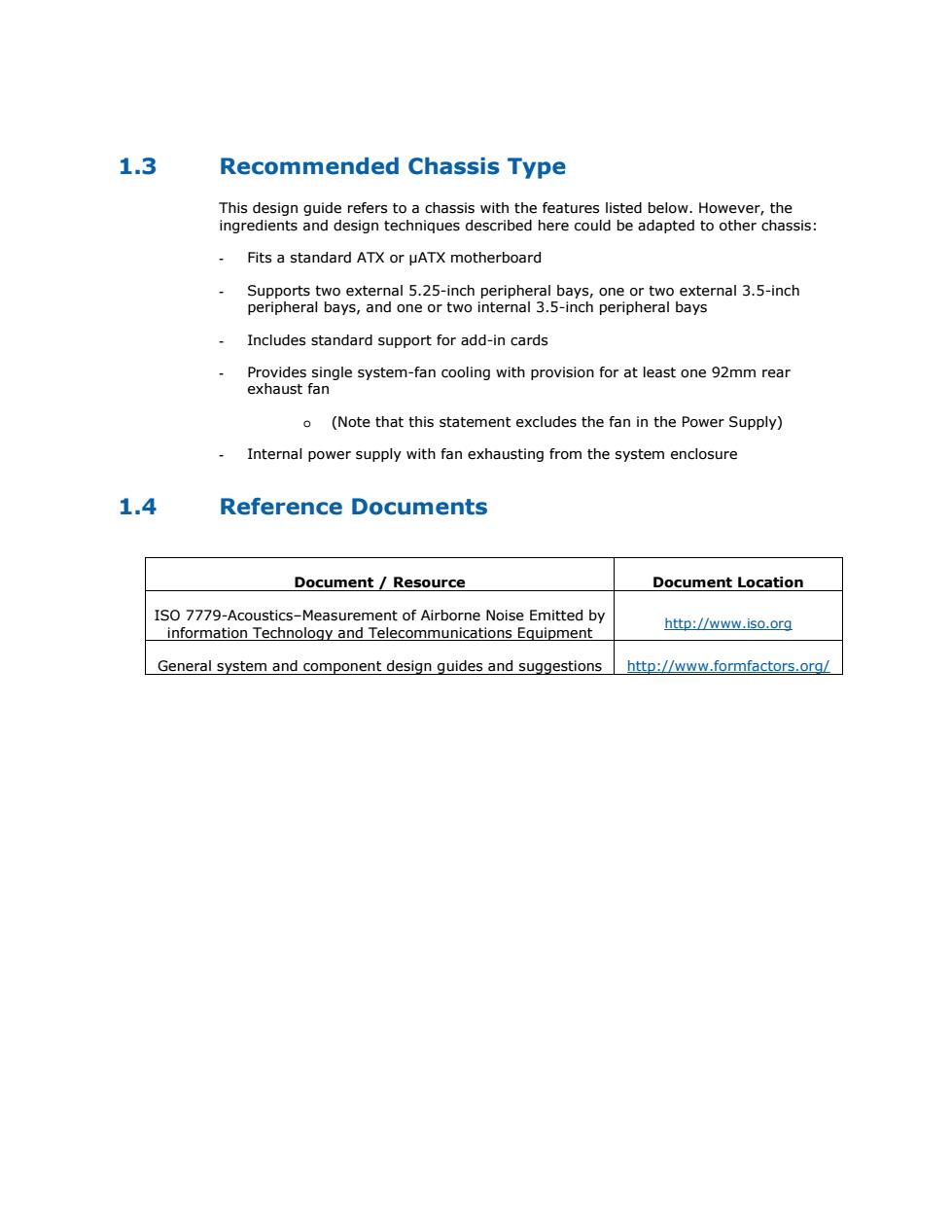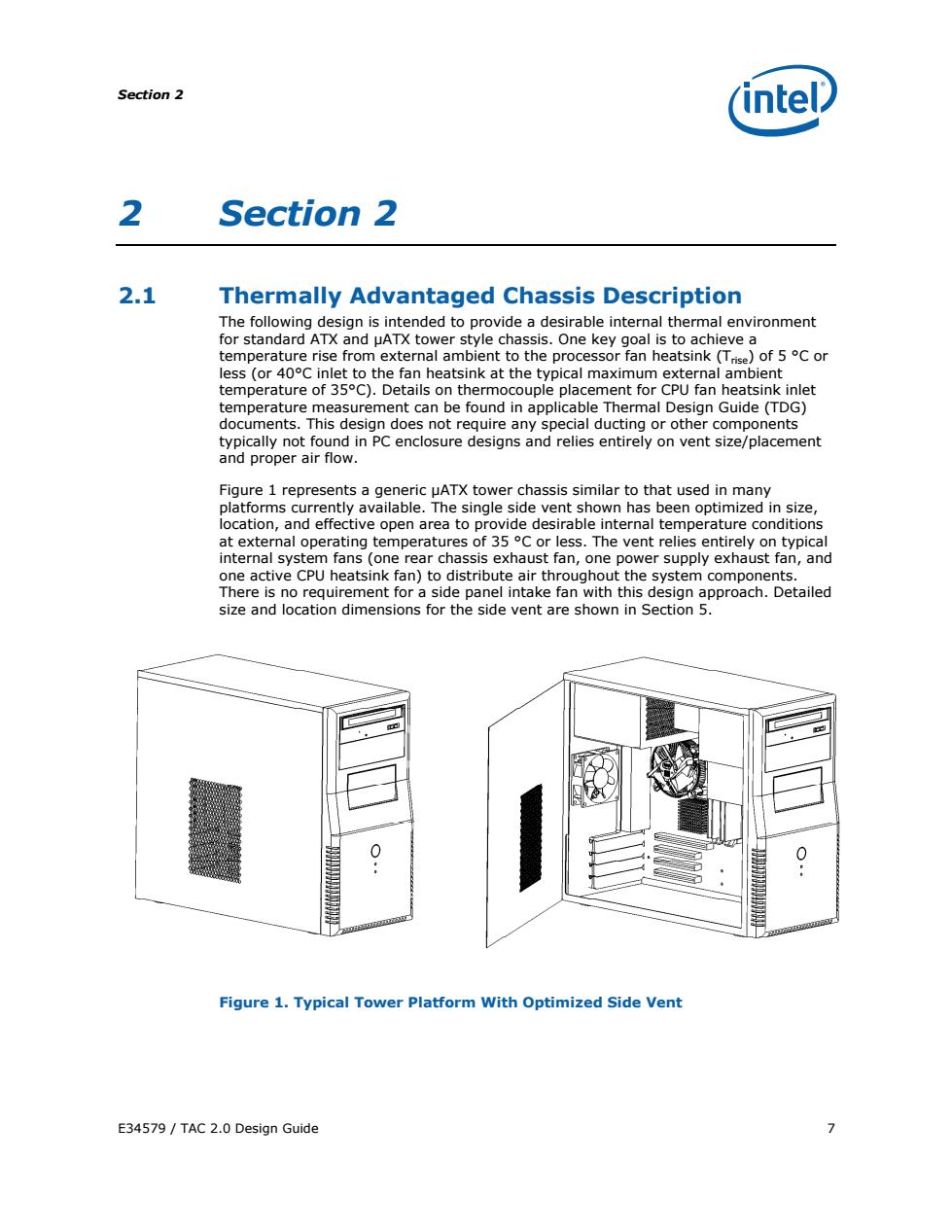
1.3 Recommended Chassis Type This design guide refers to a chassis with the features listed below.However,the ingredients and design techniques described here could be adapted to other chassis: Fits a standard ATX or uATX motherboard Supports two external 5.25-inch peripheral bays,one or two external 3.5-inch peripheral bays,and one or two internal 3.5-inch peripheral bays Includes standard support for add-in cards Provides single system-fan cooling with provision for at least one 92mm rear exhaust fan o (Note that this statement excludes the fan in the Power Supply) Internal power supply with fan exhausting from the system enclosure 1.4 Reference Documents Document Resource Document Location ISO 7779-Acoustics-Measurement of Airborne Noise Emitted by information Technology and Telecommunications Equipment http://www.iso.org General system and component design guides and suggestions http://www.formfactors.orq/
1.3 Recommended Chassis Type This design guide refers to a chassis with the features listed below. However, the ingredients and design techniques described here could be adapted to other chassis: - Fits a standard ATX or µATX motherboard - Supports two external 5.25-inch peripheral bays, one or two external 3.5-inch peripheral bays, and one or two internal 3.5-inch peripheral bays - Includes standard support for add-in cards - Provides single system-fan cooling with provision for at least one 92mm rear exhaust fan o (Note that this statement excludes the fan in the Power Supply) - Internal power supply with fan exhausting from the system enclosure 1.4 Reference Documents Document / Resource Document Location ISO 7779-Acoustics–Measurement of Airborne Noise Emitted by information Technology and Telecommunications Equipment http://www.iso.org General system and component design guides and suggestions http://www.formfactors.org/

Section 2 intel 2 Section 2 2.1 Thermally Advantaged Chassis Description The following design is intended to provide a desirable internal thermal environment for standard ATX and JATX tower style chassis.One key goal is to achieve a temperature rise from external ambient to the processor fan heatsink(Trise)of 5 C or less (or 40C inlet to the fan heatsink at the typical maximum external ambient temperature of 35C).Details on thermocouple placement for CPU fan heatsink inlet temperature measurement can be found in applicable Thermal Design Guide (TDG) documents.This design does not require any special ducting or other components typically not found in PC enclosure designs and relies entirely on vent size/placement and proper air flow. Figure 1 represents a generic uATX tower chassis similar to that used in many platforms currently available.The single side vent shown has been optimized in size, location,and effective open area to provide desirable internal temperature conditions at external operating temperatures of 35C or less.The vent relies entirely on typical internal system fans (one rear chassis exhaust fan,one power supply exhaust fan,and one active CPU heatsink fan)to distribute air throughout the system components. There is no requirement for a side panel intake fan with this design approach.Detailed size and location dimensions for the side vent are shown in Section 5. 0 Figure 1.Typical Tower Platform With Optimized Side Vent E34579/TAC 2.0 Design Guide 7
Section 2 E34579 / TAC 2.0 Design Guide 7 2 Section 2 2.1 Thermally Advantaged Chassis Description The following design is intended to provide a desirable internal thermal environment for standard ATX and µATX tower style chassis. One key goal is to achieve a temperature rise from external ambient to the processor fan heatsink (Trise) of 5 °C or less (or 40°C inlet to the fan heatsink at the typical maximum external ambient temperature of 35°C). Details on thermocouple placement for CPU fan heatsink inlet temperature measurement can be found in applicable Thermal Design Guide (TDG) documents. This design does not require any special ducting or other components typically not found in PC enclosure designs and relies entirely on vent size/placement and proper air flow. Figure 1 represents a generic µATX tower chassis similar to that used in many platforms currently available. The single side vent shown has been optimized in size, location, and effective open area to provide desirable internal temperature conditions at external operating temperatures of 35 °C or less. The vent relies entirely on typical internal system fans (one rear chassis exhaust fan, one power supply exhaust fan, and one active CPU heatsink fan) to distribute air throughout the system components. There is no requirement for a side panel intake fan with this design approach. Detailed size and location dimensions for the side vent are shown in Section 5. Figure 1. Typical Tower Platform With Optimized Side Vent